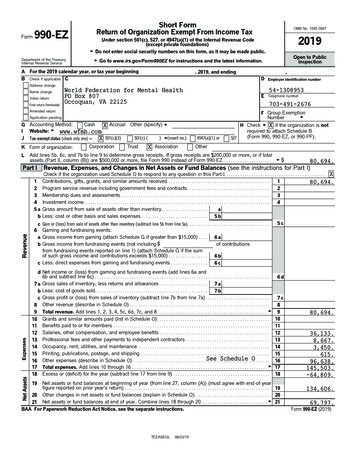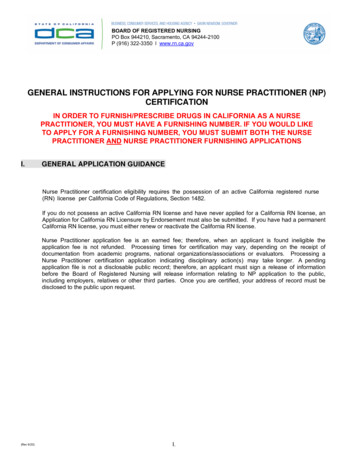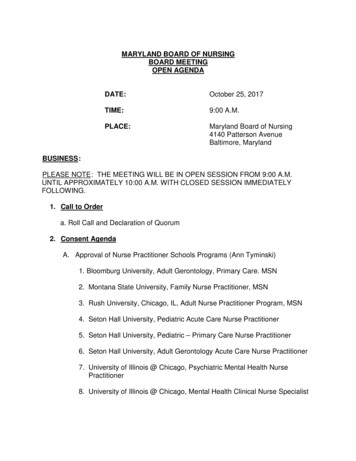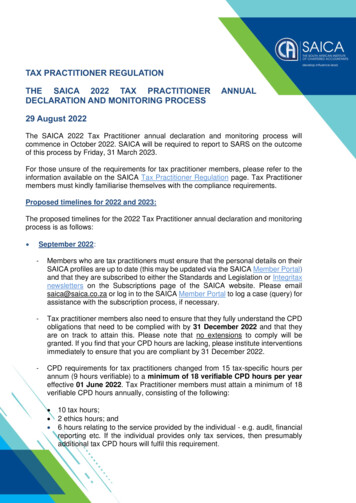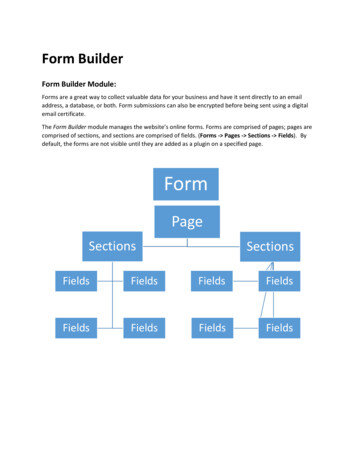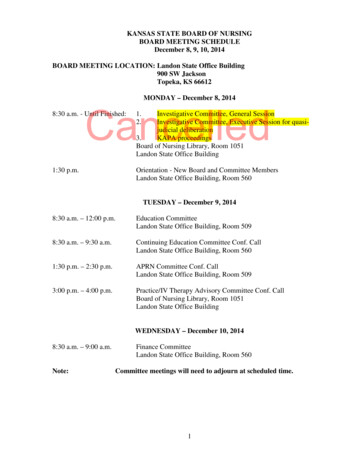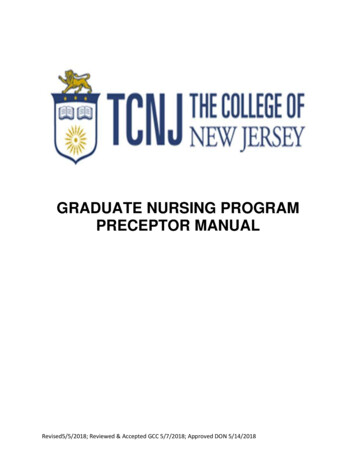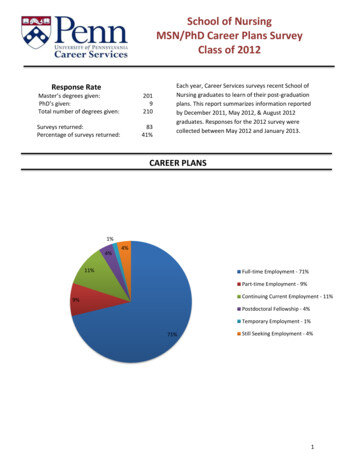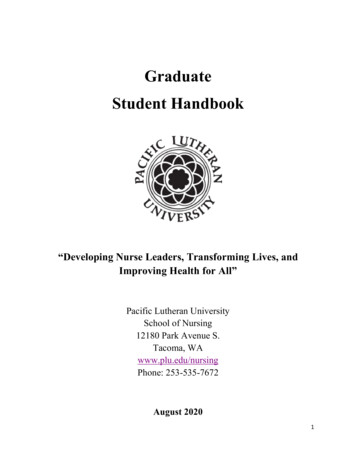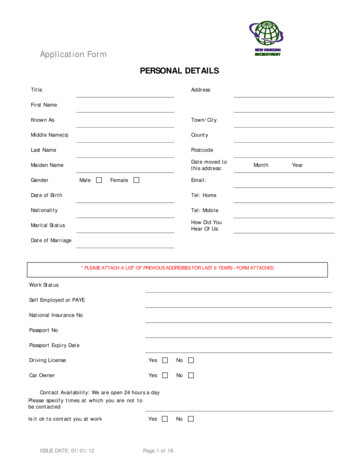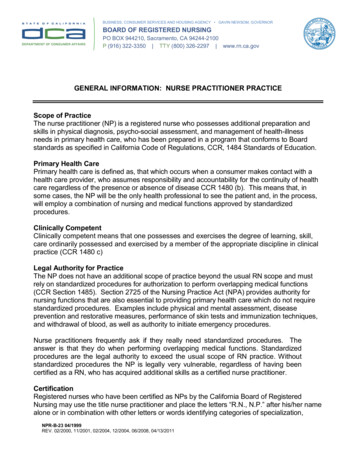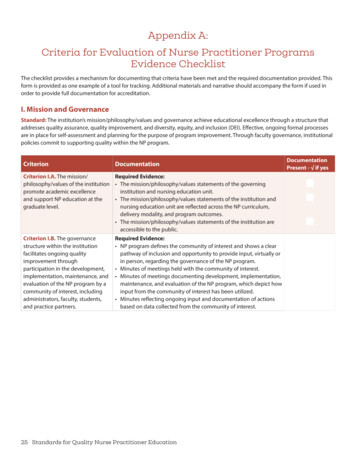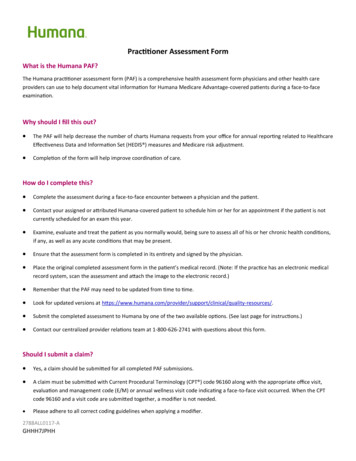
Transcription
Practitioner Assessment FormWhat is the Humana PAF?The Humana practitioner assessment form (PAF) is a comprehensive health assessment form physicians and other health careproviders can use to help document vital information for Humana Medicare Advantage-covered patients during a face-to-faceexamination.Why should I fill this out? The PAF will help decrease the number of charts Humana requests from your office for annual reporting related to HealthcareEffectiveness Data and Information Set (HEDIS ) measures and Medicare risk adjustment. Completion of the form will help improve coordination of care.How do I complete this? Complete the assessment during a face-to-face encounter between a physician and the patient. Contact your assigned or attributed Humana-covered patient to schedule him or her for an appointment if the patient is notcurrently scheduled for an exam this year. Examine, evaluate and treat the patient as you normally would, being sure to assess all of his or her chronic health conditions,if any, as well as any acute conditions that may be present. Ensure that the assessment form is completed in its entirety and signed by the physician. Place the original completed assessment form in the patient’s medical record. (Note: If the practice has an electronic medicalrecord system, scan the assessment and attach the image to the electronic record.) Remember that the PAF may need to be updated from time to time. Look for updated versions at uality-resources/. Submit the completed assessment to Humana by one of the two available options. (See last page for instructions.) Contact our centralized provider relations team at 1-800-626-2741 with questions about this form.Should I submit a claim? Yes, a claim should be submitted for all completed PAF submissions. A claim must be submitted with Current Procedural Terminology (CPT ) code 96160 along with the appropriate office visit,evaluation and management code (E/M) or annual wellness visit code indicating a face-to-face visit occurred. When the CPTcode 96160 and a visit code are submitted together, a modifier is not needed. Please adhere to all correct coding guidelines when applying a modifier.2788ALL0117-AGHHH7JPHH
Humana Practitioner Assessment FormPatient name:Humana member ID:Race/ethnicity: Asian Hispanic/Latino Asian Indian American Indian Native HawaiianDate of birth: / / Gender: Alaska Native Other Pacific Islander/ /Date of service: Male FemaleBlack/African American White/Caucasian African OtherMedical history – If marked as “active,” please also document condition in final diagnosis oviders regularly involved with care — specialists/suppliersSurgical historyProcedureReason for procedureDateSurgeon or facilityCurrent medications – Including over-the-counter medicationsName of medicationDose/frequencyConditions being treatedMedical allergies1 of 5
Patient name:Date of service:/ /Humana member ID:Date of birth:/ /Social historySocial historyRemarksAlcohol/drug useSexual historyTobacco useHigh-risk lifestyleDietPhysical ActivityFamily historyFatherRemarksMother Children Siblings Grandparents VitalsCancer Height:Diabetes Heart rate:Blood pressure: /Heart disease BMI:Hypertension BMI not completeddue to pregnancyfeet inches Weight: pounds Y NPhysical examinationWithinnormal limits AbnormalWithinnormal limits AbnormalFindingsGeneral appearance Musculoskeletal HEENT Skin Cardiovascular Neurological Respiratory Genitourinary Gastrointestinal Other Hematologic/lymphatic/immuno FindingsAdditional comments:Cognitive impairment1. Ask patient to remember the following three words, and ask the patient to repeat the words to ensure the learning was correct.BANANASUNRISECHAIR2. Ask patient to draw a clock. After numbers are on the face, ask patient to draw hands to read 20 minutes after 8 (or 10 minutes after 11).3. Ask the patient to repeat the three words given previously.Scoring instructions for recalled words and clock drawing test (CDT)Results (circle one)3 recalled words or 1-2 recalled words normal CDTPatient is negative/positive for cognitive impairmentNegative for cognitive impairment1-2 recalled words abnormal CDT or 0 recalled words Positive for cognitive impairmentAdditional comments:Cancer screening – Please fill in all appropriate dates for screening received; only ONE is needed to meet HEDIS measures under each section.Breast cancer screeningScreening not applicable If checked, move to next sectionMammography performed 27 months prior to Dec. 31 of the current measurement year/ /Excluded due to bilateral mastectomy/ /Excluded due to two unilateral mastectomies with service dates 14 days or more apart/ / and / /Excluded due to unilateral mastectomy with bilateral modifier/ /Excluded due to unilateral mastectomy code with right side modifier and a unilateral mastectomywith a left side modifier on the same or different date of service/ // /2 of 5
Patient name:Date of service:/ /Humana member ID:Date of birth:/ /Cancer screening – Please fill in all appropriate dates for screening received; only ONE is needed to meet HEDIS measures under each section.Colorectal cancer screeningColonoscopy performed in current measurement year or nine previous measurement years/ /CT Colonography performed in current measurement year or four previous years/ /Flexible sigmoidoscopy performed in current measurement year or four previous measurement years/ /FIT-DNA Test performed in current measurement year or two previous measurement years/ /Fecal occult blood test (FOBT) performed in current measurement year/ /Excluded due to total colectomy/ /Excluded due to diagnosis of colorectal cancer/ /Disease-specific managementDiabetic nephropathyScreening not applicable If checked, move to next sectionNephropathy screening: microalbumin test during calendar year/ /Nephropathy screening: macroalbumin test during calendar year/ /Is patient taking angiotensin-converting enzyme (ACE) inhibitor or angiotensinreceptor blocker (ARB) during calendar year?/ /Nephrologist visit during calendar year: Yes/ / NoRenal transplant?Diabetic eye careScreening not applicableResult: Yes NoMedication: Yes / / NoName of eye care professional If checked, move to next sectionRetinal or dilated eye exam by an eye care professional during current measurementyear/ /Negative retinal or dilated eye exam (negative for retinopathy) by an eye careprofessional during last measurement year/ /Excluded due to diagnosis of gestational diabetes during past two calendar years/ /Excluded due to diagnosis of steroid-induced diabetes during past two calendar years/ /Labs/pathologyLab not applicableTest result If checked, move to next sectionHbA1c for patients with diabetes/ /Excluded due to diagnosis of gestational diabetes in past two calendar years/ /Excluded due to diagnosis of steroid-induced diabetes in past two calendar years/ /Rheumatoid arthritis (RA) managementDiagnosis for RA not verifiedMedication name If checked, move to next sectionPrescribed or current disease-modifying antirheumatic drug (DMARD) duringcurrent measurement year/ /Excluded due to pregnancy during calendar year/ /Excluded due to diagnosis of HIV positive/ /3 of 5
Patient name:Date of service:/ /Humana member ID:Date of birth:/ /Disease-specific management – Please fill in all appropriate dates for screening received; only ONE is needed to meet HEDIS measures undereach section.Osteoporosis management in women who had a fractureScreening not applicable Medication nameIf checked, move to next sectionOsteoporosis medication was prescribed or currently taken within six months after the fracture/ /Bone mineral density test completed within six months after the fracture/ /Excluded due to bone mineral density testing within 24 months prior to fracture/ /Excluded due to osteoporosis therapy within the 12 months prior to the fracture/ /Excluded due to patient receiving osteoporosis prescription within 12 months prior to fracture/ /Excluded because fracture was a finger, toe, face or skull/ /Immunizations Influenza virus vaccine — annually/ / Pneumococcal vaccine — two recommended in lifetime OtherPCV13 / / PPSV23/ // /Screening assessmentsPain screening – Circle the level of pain patient is in on a daily basis. 0 .1 .2 .3 .4 .5 .6 .7 .8 .9 .10 No painModerate pain If pain, evidence of pain managementExtreme painFunctional status assessment Assessment of instrumental activities of daily living (ADLs) such as mealpreparation, shopping for groceries, using public transportation, housework,home repair, laundry, taking medications or handling finances Results using a standardized functional status assessmenttoolName of tool: Assessment of three of the following four components: cognitive status;ambulation status; sensory ability; other functional independence such asexercise, ability to perform job Assessment of ADLs such as bathing, dressing, eating,transferring, using toilet, walkingOther assessments Physical activityassessment Advance directive(Living will Yes/No) Fall risk assessment Depression screeningAspirin use discussion Medication review for potentially harmfuldrug-disease interactions in the elderly, such as:Diagnosis – Please provide the appropriate active diagnoses and corresponding codes.DiagnosisICD-10 codeCircle treatment t/labs/referrals/other4 of 5
Patient name:Date of service:/ /Humana member ID:Date of birth:/ /Diagnosis — ContinuedDiagnosisICD-10 codeCircle treatment s/referrals/otherScreening/prevention plan for the next five to 10 yearsFollow-up/referral/test orderedAssessment statement:Health care provider acknowledges and agrees that Humana will update and adjust this form as necessary. Updated forms will be available for use in the securesection of Humana’s website, http://www.Humana.com/providers/.Medicare payment to Medicare Advantage organizations is based, in part, on each patient’s diagnoses, as attested to by the patient’s attending health careprovider by virtue of his or her signature on this medical record. Anyone who misrepresents, falsifies or conceals essential information required for payment offederal funds may be subject to a fine, imprisonment or civil penalty under applicable federal laws.By signing this document, you attest to having reviewed the medical documents to complete the form using the best of your medical knowledge, having placedthe completed original of this form in the patient’s medical record and having ensured fully documented proof of service of all completed fields is contained inthe patient’s medical record. (Note: If the practice has an electronic medical record system, scan the assessment and attach the image to the electronic record.)To the best of my knowledge, information and belief, the information provided regarding diagnoses is truthful and accurate.Health care provider name and credentials (printed)Provider office number:Billing health care provider ID:()Health care provider signature and credentials (signed)DateProvider type: TIN NPIHealth care provider address:City, state, ZIP:5 of 5
How to Submit the Practitioner Assessment FormMethod 1: Electronic medical recordUpload electronic medical records directly to Humana using the fast and secure provider portal with the following steps:1.Go to www.submitrecords.com/humana and enter the secure password hfpaf83.2.Click the “Add files” button and choose the medical records from your Internet browser.3.Upload single records in either a PDF or TIFF format. You can batch upload a ZIP file of all records in either a PDF or TIFFformat.4.Add any information regarding the record(s) into the note section. You can add records to a maximum of 100MB of space perupload.5.Click “Upload” and the selected medical records will be electronically routed to the Humana repository system.For technical assistance with the provider upload portal, please call 1-801-984-4540. Records will be stored in the secure Humanarepository system. The website www.submitrecords.com/humana has been verified by Entrust , an identity-based securitysoftware provider. All transactions are protected by 128-bit secure sockets layer (SSL).Method 2: FaxIf you do not have online capabilities, you may fax medical records and/or completed forms to Humana medical record retrieval at1-888-838-2236. Please use a cover page and ensure that page does not contain any personal health information.
A claim must be submitted with urrent Procedural Terminology (PT ) code 96160 along with the appropriate office visit, evaluation and management code (E/M) or annual wellness visit code indicating a face-to-face visit occurred. When the PT code 96160 and a visit code are submitted together, a modifier is not needed.
